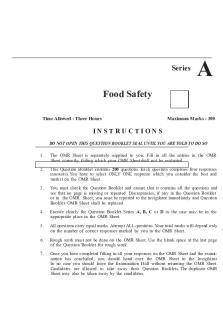Chapter 10 Food Safety Management Systems PDF

| Title | Chapter 10 Food Safety Management Systems |
|---|---|
| Course | Food Sanitation And Safety Supervision |
| Institution | Delaware County Community College |
| Pages | 2 |
| File Size | 65.3 KB |
| File Type | |
| Total Downloads | 73 |
| Total Views | 175 |
Summary
Download Chapter 10 Food Safety Management Systems PDF
Description
Discussion Questions 1. The following programs are a foundation for a food safety management system: a. Personal hygiene program b. Food safety training program c. Supplier selection and specification program d. Cleaning and sanitation program e. Standard operating procedures (SOPs) 2. There are numerous ways to achieve managerial control in the operation. According to the Food and Drug Administration (FDA), you can use simple tools such as training programs, manager supervision, and the incorporation of SOPs. Active managerial control could also be accomplished through more complex solutions, such as a HACCP program. Furthermore, monitoring is crucial to the success of active managerial control. The food would be safe if managers monitor crucial activities in the operation. Managers must take the necessary corrective action when necessary. Finally, they must ensure the actions taken to control the risk of foodborne illness are working. 3. The seven HACCP principles are: a. Principle 1: Conduct a hazard analysis b. Principle 2: Determine critical control point (CCPs) c. Principle 3: Establish control limits d. Principle 4: Establish monitoring procedures e. Principle 5: Identify corrective actions f. Principle 6: Verify that the system works. g. Principle 7: Establish procedures for record keeping and documentation 4. Certain specialized food-prep processes require a variance from the regulatory authority. They include the following: a. Smoking food as a method to preserve it (but not enhance flavor). b. Using food additives or adding components, such as vinegar, to preserve or alter it, so it no longer requires time and temperature for control for safety. c. Curing food. d. Sprouting seeds or beans. e. Offering live shellfish from a display tank. Something to Think About: Trouble at Nathan’s 1. Here is what was wrong with the way Nathan handled the crisis: a. Nathan forgot a foodborne illness or other crisis could still happen and was not prepared for it. One of his most obvious problems was that he had no communication with the media. He also failed to communicate with his key audiences, while including both his staff and customers. 2. Here is what should have been done differently:
a. With his HACCP program, Nathan needed a crisis management program. He should have started by creating a crisis management team, which would have certainly included his chef and general manager. He also could have benefitted from a communication plan, which would consist of a trained spokesperson, as well as the list of media responses that could have been used in the event of an outbreak. He even needed a plan for communicating with his staff and customers. He shouldn't have trusted the media to spread the word nor should the press have access to it. They should have been directed by staff to the spokesperson. Something to Think About: Maria’s Challenge 1. Here is what Maria did wrong: a. She started by identifying CCPs. b. She determined that the critical limit for grilled hamburgers was cooking them to 150 degrees Fahrenheit for 15 seconds. c. She determined that crucial limits would be monitored by checking for doneness using feel and color d. She failed to include record keeping in her HACCP plan. 2. Here is what Maria should have done differently: a. She should have started creating her HACCP program by conducting a hazard analysis. b. She should have conducted the accurate crucial limit for grilled hamburgers. This would include cooking them to 155 degrees Fahrenheit for 15 seconds. c. She should have identified records that should be kept. These would be important when verifying whether the HACCP program was working as intended. Study Questions 1. B 2. D 3. A 4. A 5. C 6. B 7. B 8. D...
Similar Free PDFs

FOOD SAFETY MANAGEMENT SYSTEM MANUAL
- 80 Pages

Food safety cheat sheet
- 5 Pages

KAP Food Safety proposal
- 37 Pages

Question FSO food safety
- 20 Pages

Food safety in-class assignment
- 2 Pages

Food Safety 3 - Exam 3
- 17 Pages

Colloidal Systems in Food JC
- 4 Pages
Popular Institutions
- Tinajero National High School - Annex
- Politeknik Caltex Riau
- Yokohama City University
- SGT University
- University of Al-Qadisiyah
- Divine Word College of Vigan
- Techniek College Rotterdam
- Universidade de Santiago
- Universiti Teknologi MARA Cawangan Johor Kampus Pasir Gudang
- Poltekkes Kemenkes Yogyakarta
- Baguio City National High School
- Colegio san marcos
- preparatoria uno
- Centro de Bachillerato Tecnológico Industrial y de Servicios No. 107
- Dalian Maritime University
- Quang Trung Secondary School
- Colegio Tecnológico en Informática
- Corporación Regional de Educación Superior
- Grupo CEDVA
- Dar Al Uloom University
- Centro de Estudios Preuniversitarios de la Universidad Nacional de Ingeniería
- 上智大学
- Aakash International School, Nuna Majara
- San Felipe Neri Catholic School
- Kang Chiao International School - New Taipei City
- Misamis Occidental National High School
- Institución Educativa Escuela Normal Juan Ladrilleros
- Kolehiyo ng Pantukan
- Batanes State College
- Instituto Continental
- Sekolah Menengah Kejuruan Kesehatan Kaltara (Tarakan)
- Colegio de La Inmaculada Concepcion - Cebu








